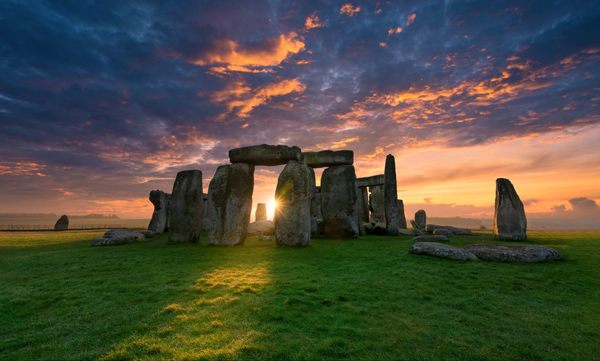The rising late summer sun cuts through the morning fog on the green expanse of Salisbury Plain in Wiltshire, England. The rays slice across a towering circle of expertly carved stone slabs, casting long shadows. A handful of men gather at the center of the prehistoric megalithic structure, their eyes on the 16-foot-long stone lying at the monument’s heart, the Altar Stone.
Like many of Stonehenge’s visitors, the men—researchers from as far as Australia—traveled here to marvel at the size and significance of the monument, which was built about 4,500 years ago. But the team of scientists also knows something the other onlookers don’t: The Altar Stone is unlike anything else at Stonehenge.
The team’s new research reveals that the stone came from northern Scotland, more than twice as far away as the other megaliths at the monument.
The paper, published today in the journal Nature, reveals that the Altar Stone most likely came from the Orcadian Basin in northeast Scotland, a large geologic formation nearly 500 miles away. Because the formation itself stretches for over a hundred miles, it’s possible the Altar Stone came from much further away. Despite the long distance involved, researchers believe the 6.6-ton Scottish rock was transported to Stonehenge by humans rather than a natural process, such as glaciation. The discovery adds to the mystery of Stonehenge but also challenges our current understanding of travel and technology in Neolithic Britain.

At a press conference announcing the find, University of Aberystwyth geologist and coauthor Richard Bevins reflected on how the team’s work caps more than a century of scientific study of the geologic origin of the megaliths. “This array of analytical equipment has given us insights that were just totally impossible for the earlier geologists studying Stonehenge,” he says. “It’s a great privilege to… unlock stories such that the likes of Herbert Henry Thomas in 1923 would not even have dreamt of.”
Geologists have long known that Stonehenge’s smaller bluestones originally came from the Preseli Hills in Pembrokeshire, Wales. In 2019, Bevins helped with a research paper pinpointing the quarry sites of the bluestones in Wales, about 180 miles from the monument. It was assumed that the Altar Stone hailed from the same area.
By late 2021, Bevins and Aberystwyth geochemist Nick Pearce had determined the Altar Stone’s age and composition didn’t match up with the Welsh bluestones, leaving its origins a mystery. In 2022, Pearce connected with Anthony Clarke, a doctoral candidate at Curtin University in Australia who was studying the age of Welsh rocks, and invited him to analyze the Altar Stone. “Of course, I immediately leapt on that opportunity,” says Clarke, who is the new paper’s lead author. In 2023, the team hinted that the Altar Stone had unique origins.
“They kind of dangled a bit of a carrot… that perhaps it came from a lot further afield,” says University of Brighton physical geographer David Nash, who has spent years researching the origins of the larger sarsen stones at Stonehenge and was not involved in the new Altar Stone research.
By testing the age and composition of mineral grains within the Altar Stone, and then comparing that to databases of local and regional rock, the team determined the stone was not from Wales or England. “It’s almost as important to figure out where stones don’t come from as where they do come from,” says Nash. “They do a really good job of knocking out a whole number of areas and then leaving the last man standing.”
Shocked to find the Altar Stone wasn’t a match for the most likely locations, the team expanded their search. The researchers determined the Altar Stone almost certainly came from a geologic sequence called the Old Red Sandstone in the Orcadian Basin, which stretches from Inverness up to Caithness and offshore through the Orkney Islands, meaning the stone may have traveled even further.
“The needle in the haystack thing now is finding which beds it might come from,” says Nash, who is delighted by the findings and says the paper shows “the possibility of material moving to Stonehenge from a very, very long way away.”

How the Altar Stone came to Stonehenge is still a mystery. Glaciers often carry massive rocks hundreds of miles and then leave them behind as erratics, but the team dismissed this possibility because glaciers covering the Orkneys never reached south central England. Their next best guess is humans; But how did they do it?
Moving a 13,000-pound-plus-megalith more than 450 miles on land, including across rugged mountains, would be “a bit of a task, to be polite about it,” says Nash with a chuckle. He says that transporting it by boat seems more plausible, because people were already using boats to move cattle and other heavy cargo.
The idea that rock from northern Scotland could end up at Stonehenge is not as far-fetched as it might seem, either. Archeological excavations northeast of Stonehenge have revealed a particular type of pottery called grooved ware, which was introduced into the British Isles via the Orkneys. “So there’s already those hints that perhaps there were ideas moving from the Orkneys southwards not long before Stonehenge was first constructed,” says Nash. The discoveries suggest that there were long-distance trade networks in place across Britain during the Neolithic, and higher levels of contact and cooperation between groups than is currently understood, however.

Perhaps the biggest question behind the discovery is why humans brought the stone hundreds of miles south. “They put some great value in bringing that stone 700, 800, 900 kilometers,” says coauthor Pearce. “Why did it mean that much to them? It gives us all something to ponder.” Some archaeologists suspect that Stonehenge was built to honor the dead, and that specific stones may have been moved distances because they honored certain people, but “Their motivations are lost to time,” says Clarke.
“We will probably never know who built Stonehenge,” says Nash. “But you’ve got hints now, haven’t you?”

